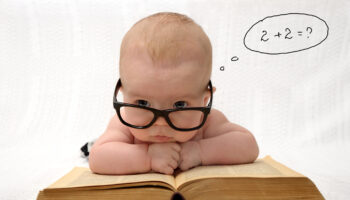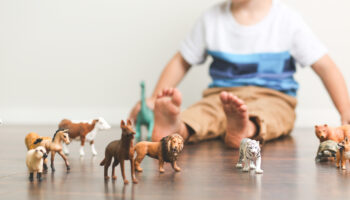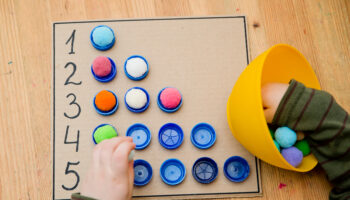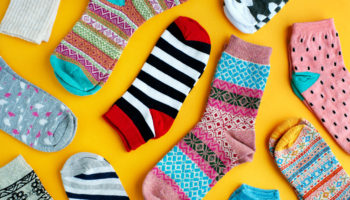Pam Schaffner
The assessment team in PA is often asked if they have any tips to make meeting quality standards easier. Since they have experiences visiting many programs in their professional careers, they have seen many programs employ strategies to make things easier, more efficient, and more effective. Implementing quality can be stressful or time consuming, but always worth it. So, this Q-T Corner moment aims at helping you along the way.
Installment #5
Math is more than what you see on paper.
How early is mathematics relevant to a child? When do math concepts need to be taught and thus included in a high-quality program? Believe it or not, prior to a child’s first birthday, a child notices mathematics, even though the child does not know that it is math that he or she is learning. To test this claim, try putting a small bowl of food or a large bowl of food (or small pile of cereal vs a large pile of cereal) in front of a child and watch them pick the larger when you ask them which bowl/pile they prefer. Toddlers will often argue over who gets the larger cup or chair when seated for lunch. Both are math concepts children are exposed to early (quantity and size comparisons).
Since math is a concept that we start to learn about (informally at a young age and then more formally as we get older), what is the best way to introduce math concepts to young children? Well, the first thing to consider is that math is imbedded into much of what we do and what we experience. The example above about the piles of cereal or the larger or smaller chair are only two such ways we experience math around us. Math is everywhere. The shapes of everyday items from a ball, to a slice of pizza, to the stop sign at the end of our street, if noted help children learn shape. Noticing that the teacher is taller than the student is a way to introduce size comparison or even measurement. Math makes the most sense to young children when it can be experienced concretely as in these examples. As we age, math is taught more formally and in more abstract terms such as x+24=26. Older children and adults can grasp the abstract, while the youngest children (those in ECE programs) need to see and be able to touch the concepts (touch a round ball, see an octagonal stop sign) in order to fully learn the concepts.
The second thing to consider is that many math toys on the market CAN teach math skills, but usually ONLY with the facilitation of a teacher. The effective and high-quality teacher will teach the children how to use a measuring tape or how to play dominoes. These items, without adult input are often not used for mathematics. Colorful counting bears are often used for dramatic play and while that is one way to use them, they are manufactured to promote math skills. A number puzzle is just some drawn lines (numerals) that children do not recognize as numbers unless helped. It takes an effective teacher to show the children that they can be used to learn math concepts.
Recognizing that some math concepts are learned early, noticing math concepts in the daily experiences of the children and pointing them out, adding materials to the classroom to promote math learning. and making sure teachers facilitate the learning while using these materials is the best recipe for promoting these skills in early childhood.
The ERS Scales measure the quality of the math experiences that the children have. A math item (or items) is included in ITERS-3 (not currently used in PA), ECERS-R, ECERS-3 and SACERS-U.
Here are some highlights from each of these scales to consider when implementing math into your program to ensure that young children get early exposure and experiences with math.
For infants and toddlers ITERS-3 (Not currently part of the Quality Rating system, however, the information is applicable to quality)
ITEM #21: Math/Number: Include items in the infant and toddler rooms such as shape sorters, toy telephones, nesting cups, books with numbers in them, easy shape puzzles, etc. Teachers can count for the children (such as count toys or crackers at snack), point out which object is biggest or smallest, or use numbers in songs such as finger plays.
For preschool/kindergarten (Programs in the Quality Rating system can choose ECERS-R or ECERS-3 and the difference between the two is that in ECERS-3 math learning is highlighted across 3 different items, while in ECERS-R there is just one item addressing math learning.)
ECERS-R:
ITEM #26: Math and number: Experience with mathematics is more elaborate and complex than it is for infants and toddlers. Materials can and should vary in complexity for children who are 3, 4, and 5 years old. A wealth of materials for math learning are included in a high-quality program. These include materials from various categories: written number, shape, counting, measurement, and comparing quantities. Oftentimes, programs set up a specific math interest center where these materials are gathered together. Math continues to be talked about as it relates to a child’s daily life as well as noting that math is everywhere. For example, a teacher may ask children to notice shapes and numbers such as on stop signs, speed limit signs, and building addresses while walking in the community.
ECERS-3:
ITEM #23: Math materials and activities: This item addresses whether materials are present for the children to use in play to promote learning about shapes, measurement and counting. Materials that help preschool children learn these concepts include counting books, dominoes, magnetic counting mazes, rulers, measure tapes, measure cups/spoons, pattern blocks, shape puzzles, etc. Adding these materials to the classroom is the first step in promoting math learning. However, the teachers must be observed talking to the children as they use these materials for maximum effectiveness and the greatest math concept learning.
ITEM #24: Math in daily events: This item measures how well staff help children notice math around them (outside of using math toys). Math can be learned as part of daily routines. For example, if a teacher helps a child notice that a cracker is square, that there are 4 crackers on her plate and that there are 3 once she eats one of them, math is being promoted as part of the routine. This item also measures how often staff refer to math concepts when children are playing with materials not manufactured for math learning. For example, a teacher could ask a child how many red crayons she has in front of her at the art table.
ITEM #25: Understanding written numbers: It is important to use numbers in the classroom. Toy telephones, play money, number puzzles and other written number materials are included in a high- quality program. However, it is important to realize something about numerals. A numeral is a symbol that represents a quantity. It has little to no meaning to a child without a representation of quantity attached to it. Would you recognize the number 3 in another language? Go online and search for “the number 3 in different languages” and see the images that come up. If someone presented you an image you have not seen before would you know that it is the number 3? Young children who have not seen numerals before will not know what they are other than pictures. If the numeral 3 is paired with a picture containing 3 fish, then children can begin to learn that 3 represents a quantity of something. Including posters that show numerals and quantity, center signs with numerals and a corresponding number of spots for children to add their name during play, puzzles where a quantity is matched with a numeral are examples of what can be included to promote the learning of written numbers. Add in quality interactions with the teacher who uses these materials with the children, and you have a recipe for some high-quality learning.
School age children (SACERS-U):
ITEM #24: Math/reasoning activities: For school age children, make sure that math games and activities are geared towards the age of the children. For example, math games for a 1st grader will be much less complex/difficult than games for a 5th grader. Have games/activities for all ages you serve. Examples include dominoes, Monopoly, Trouble, Uno, measuring materials, Perfection, etc. Staff should engage in these games and activities with the children and help when needed. Math, as seen in daily events, is also important to point out for school age children. The children can set the table for snack by counting an attendance record and comparing it to the number of children who are present, etc.




